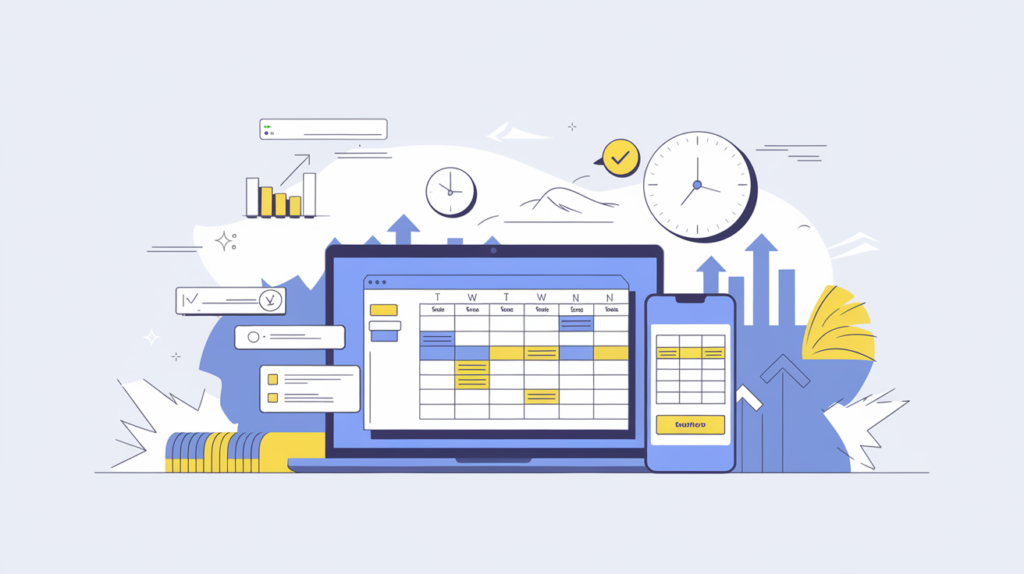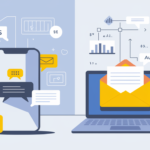- Calendar Sync Options: Avoid double-booking with real-time syncing across Google Calendar, Outlook, and more.
- Automatic Appointment Reminders: Reduce no-shows by 29% with SMS, email, or phone reminders.
- Multiple Booking Channels: Let clients book via your website, social media, or mobile-friendly platforms.
- Booking Rules and Limits: Set buffer times, lead times, and capacity limits for smoother scheduling.
- Customer Information Management: Centralize client data for tailored services and loyalty-building.
- Built-in Payment Options: Simplify payments, reduce no-shows, and integrate with platforms like Square or Stripe.
- Data and Performance Tracking: Use analytics to monitor booking trends, revenue, and customer behavior.
Quick Comparison
| Feature | Key Benefit | Example Tools |
|---|---|---|
| Calendar Sync | Avoid double-booking | SimplyBook.me, Acuity |
| Automatic Reminders | Reduce no-shows | AI Front Desk, Setmore |
| Multiple Booking Channels | Client convenience | Reserve with Google |
| Booking Rules & Limits | Manage availability effectively | Square Appointments |
| Customer Info Management | Personalize services | TIMIFY, Looker |
| Built-in Payments | Streamline transactions | Square, Stripe |
| Data & Performance Tracking | Optimize operations with analytics | Power BI, Tableau |
These features save time, improve customer satisfaction, and grow revenue. Start with tools offering these essentials to simplify scheduling and enhance your business operations.
Top 5 Free Appointment Scheduling Software and their key features
1. Calendar Sync Options
Keeping your schedule in order can be a challenge without proper tools. Calendar synchronization helps avoid double-bookings and scheduling mishaps. Most scheduling software integrates with popular platforms like Google Calendar, Outlook, and iCloud, keeping your availability updated across all your devices.
Real-time syncing can cut appointment conflicts by 30% and improve customer satisfaction by 25% [1].
Here’s a quick look at how some top scheduling tools manage calendar integration:
| Software | Supported Calendars | Sync Type |
|---|---|---|
| Acuity Scheduling | Google Calendar, iCloud, Microsoft Exchange, Office 365, Outlook.com | 2-way or 1-way sync options |
| Setmore | Google Calendar, Office 365 | 1-way sync (free), 2-way sync (paid) |
| SimplyBook.me | Google Calendar, Outlook | 2-way sync |
| Book Like A Boss | Google Calendar, Microsoft Exchange, Outlook, iCloud, Office 365 | 2-way sync |
This integration ensures that any booked time slots are automatically blocked across all your calendars, simplifying the scheduling process.
For example, if your Google Calendar has a meeting scheduled, the software automatically blocks that time slot from being booked by others. This two-way syncing keeps everything in sync – any updates in one calendar immediately show up across the others [3].
Some advanced features take calendar syncing to the next level:
- Automatic buffer times between appointments help you avoid back-to-back scheduling stress [2].
- Cross-referencing calendars gives you a unified view of all events, reducing the risk of overlaps [4].
To get the most out of your scheduling software, opt for tools that offer two-way synchronization with your primary calendar. This ensures that whether you update your schedule through the software or directly in your calendar, everything stays aligned. It’s a simple way to save time, reduce admin work, and keep your appointments accurate [4].
2. Automatic Appointment Reminders
Missed appointments can disrupt operations and cut into revenue. Modern scheduling tools address this issue by sending automated reminders to clients about their upcoming appointments [5]. Depending on the industry, no-show rates can vary widely, from 12% to 80% [7]. For example, Community Health Network managed to retain over $3 million in revenue and reduced their no-show rate by 1.2% after adopting an automated reminder system [6]. Let’s dive into how communication methods impact the success of these reminders.
The effectiveness of reminders often depends on the communication channel. SMS reminders, with an impressive 98% open rate, are highly effective for quick confirmations [9]. A survey of 14,000 patients revealed that 48% prefer text messages, 29% prefer phone calls, and 21% favor emails [10]. This shows that tailoring reminders to match client preferences can significantly improve attendance rates.
Here’s a real-world example: a local wellness center saw no-show rates drop by 50% after using AI Front Desk’s reminder system. Client satisfaction also increased from 75% to 92%, leading to more confirmed appointments [8].
To get the most out of your reminders, consider these tips:
- Send notifications about 24 hours before the appointment.
- Personalize messages with the client’s name and service details.
- Provide clear options to confirm, cancel, or reschedule.
- Use multiple channels for critical appointments.
The numbers don’t lie: 64% of consumers say appointment reminder texts are the most useful messages they receive from businesses [9]. Additionally, fewer than 5% of appointments are canceled after a text reminder is sent [9]. When choosing scheduling software, prioritize platforms that offer customizable reminders and multi-channel communication. This ensures your reminders align with client preferences while maintaining a consistent brand tone.
3. Multiple Booking Channels
Offering multiple ways for clients to book appointments is a smart move for business growth [15]. Just like automated reminders and calendar syncing simplify scheduling, having diverse booking options makes it easier for clients to connect with your business. In fact, 94% of clients are more likely to choose a service provider that offers online booking [15].
The appointment scheduling market is expected to hit $1.55 billion by 2032 [12]. Consumer behavior has also shifted significantly. Before the pandemic, only 37% of Americans shopped online five or more times a month, but now that number has climbed to 55% [12]. These changes highlight the need for businesses to offer booking options that work across multiple platforms.
Here are some strategies to consider:
-
Website Integration: Adding scheduling tools to your website allows clients to book anytime. Birds Barbershop’s co-founder Jayson Rapaport shared:
"Letting our guests manage their own appointments from start to finish has been a huge benefit for us. We’ve eliminated front desk lines and the phone doesn’t ring as much, so our team can focus 100% on taking care of guests in the chair" [16].
- Social Media Booking: Use platforms like Reserve with Google and Meta to let clients book directly through social media [13].
- Mobile-Friendly Design: With 46% of clients now booking appointments online [15], your booking system must work well on all devices.
Key Features for Multi-Channel Booking
| Feature | Benefit |
|---|---|
| Real-time Calendar Sync | Avoids double bookings across platforms |
| Automated Confirmations | Cuts down on administrative tasks |
| Time Zone Detection | Ensures accurate scheduling for all clients |
| Custom Branding | Provides a consistent client experience |
Managing all appointments through a single, unified dashboard ensures everything stays organized [14]. This approach not only makes life easier for your team but also creates a smoother experience for clients. As one industry expert put it:
"People place great value on their time and are likely to shift to a company that recognizes the importance of time management" [11].
sbb-itb-1c6633a
4. Booking Rules and Limits
Setting clear booking rules helps manage availability, buffer times, and booking windows, making scheduling much smoother.
Buffer Time Management
Buffer times are the gaps between appointments. They give providers time to prepare, handle any delays, and manage setup or cleanup efficiently.
Key Scheduling Parameters
Here are some critical parameters to consider for effective scheduling:
| Parameter Type | Purpose | Suggested Setting |
|---|---|---|
| Booking Lead Time | Minimum notice required | 24–48 hours in advance |
| Buffer Duration | Time between appointments | 15–30 minutes |
| Scheduling Window | Maximum advance booking period | 2–3 months ahead |
| Capacity Limits | Maximum bookings per time slot | Based on staff availability |
These settings provide a solid foundation for handling appointments effectively.
Advanced Booking Controls
Modern scheduling tools offer advanced features that help refine your booking process. Heather Stephens emphasizes the importance of clear communication:
"Clearly communicate your cancellation policy, rescheduling procedures, and any requirements or materials clients need to prepare before their appointment. This helps manage expectations and ensures that both you and your clients are on the same page." [18]
Here are some ways advanced booking controls can improve your scheduling:
- Limit the number of daily appointments and control start times
- Adjust reservation lengths to fit specific needs
- Manage availability during peak hours
- Enable waiting list options for better flexibility [17]
These controls, paired with calendar syncing and automated reminders, create a more efficient and reliable scheduling system.
5. Customer Information Management
Managing customer data effectively goes hand in hand with strong booking systems. It allows businesses to provide tailored services, improve operations, and build lasting customer loyalty. Modern scheduling software now goes beyond simple contact storage, offering tools to centralize information, integrate systems, and use data smartly. Here’s how these features can improve the customer experience.
Centralized Client Profiles
A centralized client profile keeps important customer details and preferences in one place. Studies show that 91% of customers are more likely to stay loyal to brands that remember their preferences [20].
Here’s how specific types of data can enhance service:
| Data Type | Business Impact | Service Improvement |
|---|---|---|
| Contact Details | Easier communication | Multi-channel engagement |
| Service History | Deeper insights | Tailored recommendations |
| Preferences | Better customer experience | Customized scheduling options |
| Payment Information | Faster transactions | Automated billing |
Integration Capabilities
Modern scheduling platforms easily connect with CRM systems, creating a unified view of customer interactions. This integration can yield an impressive $30.48 return for every dollar invested [20].
Smart Data Management
Disorganized data can cost companies up to $13 million annually [21]. Advanced tools in scheduling software help avoid this by ensuring:
- Real-time updates across all platforms
- Automated data checks to reduce errors
- Secure storage for sensitive details
- Custom fields tailored to specific industries
Automated Follow-up Systems
Many scheduling platforms also offer automated follow-up features to keep communication consistent. TIMIFY highlights this by stating:
"Appointment scheduling software is an essential tool for businesses looking to ensure consistency across multiple touchpoints" [19]
These tools allow businesses to:
- Automatically send appointment confirmations
- Track customer interactions
- Schedule follow-up messages
- Measure customer satisfaction
6. Built-in Payment Options
Having payment processing directly integrated into appointment scheduling software can simplify finances and help reduce no-shows. In fact, data shows that integrated payment options can double the number of scheduled appointments [23]. Let’s break down how payment gateways and prepayment methods make this possible.
Payment Gateway Integration
Many scheduling platforms work with various payment processors, offering flexibility for businesses. Here’s a quick comparison:
| Payment Provider | Key Features | Transaction Fees |
|---|---|---|
| Square | POS integration, card readers, digital wallets | 2.6% + $0.15 per transaction |
| Stripe | Online payments, Tap to Pay, wallet support | Varies by plan |
| PayPal | Global reach, booking page payments | Varies by region |
| LawPay | Tailored for professional services, compliance-focused | Industry-specific |
Reducing No-Shows Through Prepayments
Charging prepayments or no-show fees can significantly reduce missed appointments. Around 25% of physician practices now implement no-show fees [24]. Dan White from Dapper Dan’s Barbershop & Shave Parlor shares his experience:
"Square acts as my receptionist. It eliminates a lot of the handwork I have to do." [22]
Payment Features
Today’s scheduling software includes features that make payment handling straightforward:
- Prepayment Options: Accept full payments or deposits upfront.
- Cancellation Fees: Apply charges for late cancellations automatically.
- Secure Payment Storage: Save card details for repeat customers.
- Flexible Payment Methods: Support for cards, digital wallets, and contactless payments.
These tools integrate easily with existing financial systems, streamlining overall operations.
Financial Management Integration
J. Burnett-Petite of JP Advising highlights the convenience of combining scheduling with financial tools:
"Square Appointments is how I stay organized. It’s so convenient to access other Square tools, like invoices, through the (Square) Appointments app!" [22]
Pricing Considerations
Here’s a snapshot of pricing for some popular scheduling platforms:
- Acuity Scheduling: Starts at $16/month for a single staff member [4].
- Square Appointments: Free for single-location users, with premium features from $29/month [4].
- SimplyBook.me: Free for up to 50 bookings per month, with paid plans starting at $8.25/month [4].
Integrated payment systems not only improve efficiency but also help businesses communicate policies clearly. For example, 41.6% of patients reportedly don’t know about no-show policies [24]. Automated payment features can bridge this gap, ensuring smoother operations and better customer understanding.
7. Data and Performance Tracking
Scheduling software provides powerful tools to analyze data and make informed decisions. By focusing on key metrics, businesses can improve efficiency and enhance customer satisfaction.
Key Metrics to Keep an Eye On
| Metric | Description | Business Impact |
|---|---|---|
| Booking Conversion Rate | Percentage of website visitors who complete a booking | Measures how effective your marketing efforts are |
| Booking Lead Time | Time between booking and the actual appointment | Helps with better capacity planning |
| Cancellation Rate | Percentage of canceled appointments | Highlights areas of potential revenue loss |
| Repeat Booking Rate | Percentage of customers who return | Reflects customer loyalty and satisfaction |
| Revenue per Booking | Average earnings per appointment | Tracks financial performance and profitability |
Real-World Examples of Success
Analytics have proven to save costs and streamline scheduling. For instance, Hyatt used predictive analytics to save $4.4 million [26]. Meanwhile, Qantas adopted real-time data analytics to improve schedule recovery and deliver a better travel experience [26].
Tools to Visualize Your Data
Top scheduling platforms offer tools to make data easier to understand and act on:
- Tableau: Combines with CRM systems for a detailed look at booking trends [28].
- Power BI: Works seamlessly with Microsoft tools to deliver in-depth reports [28].
- Looker: Provides real-time dashboards for immediate insights [28].
These tools help businesses turn raw data into actionable insights.
How Analytics Drive Business Growth
Analytics directly impact business performance by uncovering opportunities to optimize operations. For example:
- Personalized services can boost revenue by 40% and engage 80% of customers [26].
- Salons lose about $2,500 annually due to no-shows, showing the importance of addressing this issue [27].
"Predictive analytics is taking how salons traditionally manage their bookings and moving it up to the next level, offering a smarter way to anticipate client behaviors and streamline operations." [27] – Darius Jokubaitis, CMO of Attention Insight
Practical Strategies for Using Analytics
- Track Peak Times: Use booking data to adjust staffing levels during busy and slow hours [27].
- Understand Customer Behavior: Study patterns like cancellations and preferences to create effective reminders, reduce no-shows, and tailor marketing campaigns [27].
- Maximize Revenue: Use dynamic pricing based on demand or seasonality and offer add-ons to increase earnings [25].
Advanced Features to Look For
Modern scheduling software often includes:
- Real-time updates on dashboards
- Customizable reports
- Comparisons across multiple locations
- Revenue forecasting tools
- Insights into customer behavior
With these features, businesses can make smarter decisions about staffing, marketing, and services, ultimately improving overall performance.
Conclusion
Picking the right appointment scheduling software can revolutionize how your business operates. The seven features we’ve covered provide a solid foundation for evaluating your options.
Making an Informed Decision
When assessing scheduling tools, keep these key areas in mind:
| Priority Area | Key Considerations | Business Impact |
|---|---|---|
| Core Functionality | Calendar sync, reminders, multiple booking channels | Simplifies administrative workflows |
| User Experience | Intuitive interface and mobile accessibility | Improves the customer booking experience |
| Business Growth | Scalability, analytics, and payment processing | Drives higher customer spending [31] |
| Technical Requirements | Integration options and security measures | Ensures smooth, secure platform operations |
These considerations not only improve operational efficiency but can also lead to measurable financial benefits.
Measuring Return on Investment
Scheduling software has a proven track record for boosting business performance. For instance, 90% of financial institutions report increases in new accounts and balances after adopting these tools [31].
"When choosing an online scheduling software, make sure you’re considering the cost incurred by not having the tools you need to automate appointment related tasks." – TimeTap [29]
Future-Proofing Your Choice
As customer interactions increasingly shift online – 50% now occur through digital channels [32] – it’s essential to select software that grows with your business. Look for features such as:
- Secure Storage: Cloud-based encryption to protect client data
- Scalability: Ability to handle more appointments and locations as your business expands
- Integration: Seamless connection with existing tools like CRM systems
Planning for the future ensures your scheduling solution remains effective as your business evolves.
Expert Recommendation
"Choosing the right scheduling software is a crucial step in optimizing your appointment management and enhancing productivity." [30]
Take advantage of free trials to test these features and ensure you select a booking system that meets your needs and supports business growth.


